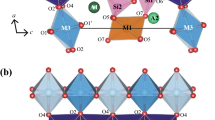Abstract
Three volcanic dykes, rhyolite, dacite and trachyandesite cutting a radioactive granite, located between Latitudes 22° 47′ 396″–22° 47′ 884″ N and Longitudes 31° 54′ 883″–31° 54′ 894″ E in the south Western Desert of Egypt were sampled and analyzed by X-ray diffraction, 57Fe Mössbauer spectroscopy and chemical method. They are consisted of feldspar and quartz together with some paramagnetic minerals including aegirine plus minor riebeckite in the rhyolite; aegirine plus some riebeckite in the dacite; and riebeckite plus trace aegirine in the trachyandesite, respectively. The bulk content of iron in each dyke has characteristic ferric-quadrupole splitting and oxidation values: 0.29 millimeters per second (mm/s) and 100% for rhyolite; 0.31 mm/s and 82% for dacite; and 0.35 mm/s and 0.69% for trachyandesite. Variations in the quadrupole splitting have been attributed to changes from the local crystal chemistry, while the oxidation variations are source-related.
Similar content being viewed by others
References
Hassan, K.M.: Geochemical assessment of radioactive lava pockets in El-Seboah granite, Toshki area, south Western Desert, Egypt. Ann. Geol. Surv. Egypt XXVIII, 195 (2005)
Bahgat, A.A., Hassan, K.M.: Mixed valent iron in biotite. Hyp. Interact. 41, 755 (1988)
Bahgat, A.A., Abu El-Lell, I., Radan, T.M.: Gabbro-metgabbro association: a Mössbauer effect study. Hyp. Interact. 70, 949 (1992)
Eissa, N.A., Abou Sehly, A.A., Shash, N., Salman, F., El Bahnassawy, H.H.: Mössbauer spectra electrical and thermal conductivities of Egyptian granite. Arab J. Nucl. Sci. Appl. 27–2, 109 (1994)
Eissa, N.A., Sallam, H.A., Sheta, N.H., El Bahnassawy, H.H.: Mössbauer effect study of biotite from Egyptian granite rocks. Arab J. Nucl. Sci. Appl. 27–2, 97 (1994)
Eissa, N.A., Sallam, H.A., El Bahnassawy, H.H.: Mössbauer study of Egyptian granite. Arab J. Nucl. Sci. Appl. 27–2, 87 (1994)
Shapiro, L., Brannock, W.W.: Rapid analysis of silicate, carbonate, and phosphate rocks. U.S. Geol. Surv. Bull. 1144 A, 5 (1975)
De Grave, E., Van Alboom, A., Eeckhout, S.G.: Electronic and magnetic properties of a natural aegirine as observed from its Mössbauer spectra. Phys. Chem. Miner. 25, 378 (1998)
Dollase, W.A., Gustafson, W.I.: 57Fe Mössbauer spectral analysis of the sodic clinopyroxenes. Am. Mineral. 67, 311 (1982)
Bancroft, G.M., Maddock, A.G., Burns, R.G.: Applications of Mössbauer effect to silicate mineralogy-I. Iron silicates of known crystal structure. Geochim. Cosmochim. Acta. 31, 2219 (1967)
Author information
Authors and Affiliations
Corresponding author
Rights and permissions
About this article
Cite this article
Hassan, K.M. Rhyolite–dacite–trachyandesite association: a Mössbauer spectroscopy study. Hyperfine Interact 192, 101–107 (2009). https://doi.org/10.1007/s10751-008-9904-5
Received:
Revised:
Published:
Issue Date:
DOI: https://doi.org/10.1007/s10751-008-9904-5



